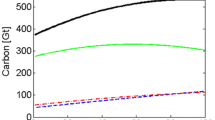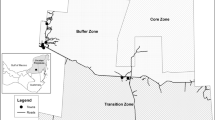Abstract
Concern about the issue of permanence andreversibility of the effects of carbon sequestrationhas led to the need to devise accounting methods thatquantify the temporal value of storing carbon that hasbeen actively sequestered or removed from theatmosphere, as compared to carbon stored as a resultof activities taken to avoid emissions. This paperdescribes a method for accounting for the atmosphericeffects of sequestration-based land-use projects inrelation to the duration of carbon storage. Firstly,the time period over which sequestered carbon shouldbe stored in order to counteract the radiative forcingeffect of carbon emissions was calculated, based onthe residence time and decay pattern of atmosphericCO2, its Absolute Global Warming Potential. Thistime period was called the equivalence time, andwas calculated to be approximately 55 years. From thisequivalence time, the effect of storage of 1 tCO2 for 1 year was derived, and found to besimilar to preventing the effect of the emission of0.0182 tCO2. Potential applications of thistonne.year figure, here called the equivalencefactor, are then discussed in relation to theestimation of atmospheric benefits over time ofsequestration-based land use projects.
Similar content being viewed by others
References
Chomitz, K.: 1998, 'The permanence and duration issue in carbon offsets based on sequestration', Draft paper, Development Research Group, World Bank.
Dixon, R.K., Winjun, J.K., Adrasko, K.J. and Schroeder, P.E.: 1994, 'Integrated land-use systems: assessment of promising agroforestry and alternative land-use practices to enhance carbon conservation and sequestration', Climate Change 30, 1–23.
Dobes, L., Enting, I. and Mitchell, C.: 1998, 'Accounting for carbon sinks: the problem of time', in L. Dobes (ed.), Trading Greenhouse emissions: some Australian perspectives, Occasional papers No. 115, Bureau of Transport Economics, Australia.
Fearnside, P., Lashof, D. and Moura-Costa, P.: 2000, 'Accounting for time in mitigating global warming', Mitigation and Adaptation Strategies for Global Change. Submitted.
Fearnside, P.: 1997, 'Monitoring needs to transform Amazonian forest maintenance into a global warming-mitigation option', Mitigation and Adaptation Strategies for Global Change 2, 285–302.
Greenhouse Challenge Office: 1997, Greenhouse Challenge Carbon Sinks Workbook: A Discussion Paper, Greenhouse Challenge Office, Canberra, Australia.
Houghton, J.T., Jenkins, G.J. and Ephramus, J.J. (eds.).: 1990, Climate Change: The IPCC Scientific Assessment, Cambridge University Press, Cambridge, UK, 365 pp.
Houghton, J.T., Callander, B.A. and Varney, S.K. (eds.).: 1992, Climate Change 1992: The Supplementary Report to the IPCC Scientific Assessment, Cambridge University Press, Cambridge, UK, 198 pp.
Houghton, J.T., Meira Filho, L.G., Bruce, J., Hoesung Lee, Callander, B.A., Haites, E., Harris, N. and Maskell, K. (eds.): 1994, Climate Change 1994: Radiative Forcing of Climate Change and an Evaluation of the 1992 IPCC IS92 Emissions Scenario, Cambridge University Press, Cambridge, UK, 339 pp.
Kyoto Protocol: 1997, www.unfccc.de.
Moura Costa, P.: 1996, 'Tropical forestry practices for carbon sequestration', in A. Schulte and D. Schone (eds.), Dipterocarp Forest Ecosystems-Towards sustainable management, World Scientific, Singapore, pp. 308–334.
Price, C. and Willis, R.: 1993, 'Time, discounting and the valuation of forestry's carbon fluxes', Commonwealth Forestry Review 72, 265–271.
Schroeder, P.: 1992, 'Carbon storage potential of short rotation tropical tree plantations', Forest Ecology and Management 50, 31–41.
Tipper, R. and de Jong, B.H.: 1998, 'Quantification and regulation of carbon offsets from forestry: comparison of alternative methodologies, with special reference to Chiapas, Mexico', Commonwealth Forestry Review 77, 219–228.
Wigley, T.M.L.: 1994, 'How important are carbon cycle model uncertainties?', in T. Hanisch (ed.), Climate Change and the Agenda for Research, Westview Press, Boulder, CO, pp. 169–191.
Author information
Authors and Affiliations
Rights and permissions
About this article
Cite this article
Moura Costa, P., Wilson, C. An equivalence factor between CO2 avoidedemissions and sequestration – description andapplications in forestry. Mitigation and Adaptation Strategies for Global Change 5, 51–60 (2000). https://doi.org/10.1023/A:1009697625521
Issue Date:
DOI: https://doi.org/10.1023/A:1009697625521




